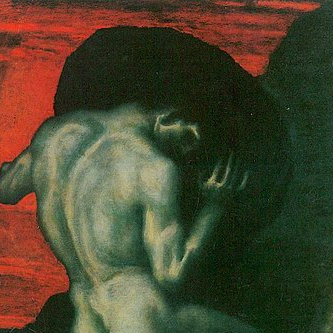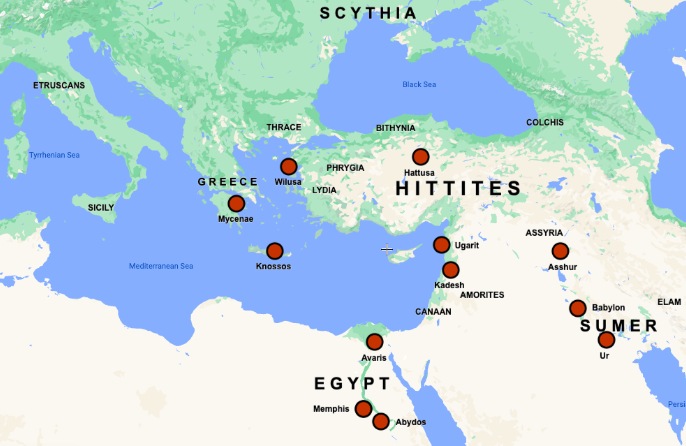Texts in Context:
The Bronze Metallists

By Gabriel Blanchard
At its height, the Bronze Age had almost everything we mean by civilization today: war, taxes, commerce, politics, gaudy monuments, and something called "Amazon."
This post is part of a series on the historical context of our Author Bank; it includes introductory posts on historiography, periodization, and pseudohistory.
In this series, we have discussed the transition from prehistory to history (a little bit); we have also touched on some of the social, moral, and ritual aspects of Bronze Age societies, which were not quite—were not nearly—so savage as people often suppose, as exemplified in dramatic verse like the Iliad, or the wisdom literature that informs the Epic of Gilgamesh. (Of our authors, only the poet who composed the Gilgamesh was certainly of this period. Homer’s works, though set back then, more probably date to the early Iron Age; the only other possibles, who are more likely also Iron Age figures, are Hesiod, Æsop, and Confucius—the last less due to ancientry than because the Chinese Bronze Age occurred at slightly later dates than the Near Eastern.) But all these are books, which have an ambivalent relationship to life. What was the Bronze Age world really like? And the answer to that is, it was a lot more like the modern world than you might suppose.
To start with, let’s get a visual idea of the places we’re talking about in what is now southeastern Europe, the northerly half of the Near East, and northeastern Africa. Below is a map showing some of the important cities, realms, and people groups that were active in this region during the Bronze Age.

These cultures were all in contact with each other, at greater or lesser removes, and they all traded with each other; these were facts of daily life even then. No, sending a message from, say, Asshur to Mycenæ wasn’t nearly as fast or convenient then as sending an email from Alaska to Mississippi is now; and as for trade, the only Amazon that existed was the kind that would cut off your head before you could get your sword out, and then probably brandish it at your friends, daring them to just try and invade her lands one more time. But still, if you wanted something you couldn’t make, grow, raise, gather, catch, tame, or steal yourself, it would have to be shipped to you—perhaps literally.
In other words, you would need to either know a merchant or be one. You would also need to have exactly the goods that he wanted in exchange for his wares—and not just have them, but (a) be able to afford to part with them, and (b) have them in the quantity and quality that the merchant considered up to snuff; this is, of course, the big drawback of barter. But the goods concerned might come from quite far afield: the purple dye that made the Phoenicians famous got sold all over the Mediterranean, and they went as far afield as Britain to obtain tin—they were not renowned seafarers for nothing! Tin was important as one of the normal ingredients in our all-important alloy, bronze. (Bronze could also be made using arsenic, and arsenical bronzes actually seem to be the older ones on the whole. However, it was soon observed that these bronzes are toxic.**)
Overland trade routes also existed. These had the drawback of being slower: the sea permits movement in a straight line, and remains consistently at sea level, whereas land will pitch up and down and put any number of disobliging thickets, deserts, and swamps in one’s way. But there are perks to land travel: it is nearly impossible to be capsized and drowned by a storm while on land, and you hardly ever need to build a boat to traverse it. Things could be traded by land, and they were. Vanilla, of all things, has been detected in a few Canaanite tombs, which would have had to come from East Africa or even Indonesia!† The Near Eastern trades in amber from the Baltic and silk from China, though they are attested much later, took place in essentially similar conditions and with similar technologies available, illustrating the distances that could be conquered even when Khufu was having the Great Pyramid constructed and surfaced with white limestone, making it all but glow at night and flash with intolerable brilliance in the sun; or when Hammurabi was erecting the seven-foot basalt stele that encoded his laws in over four thousand lines of inscribed cuneiform; or when a Greek warlord sat in the palace at Mycenæ, sharpening his brazen spear as he prepared to lead the Achæan Coalition against Wilusa.
There were giants in the earth in those days; and also after that ...
Genesis 6.4
These three figures call up a few more aspects of the Bronze Age that merit our attention. One, which is displayed at its most spectacular in Egypt, is monumental architecture. “Monumental” here is not just a synonym for “amazing.” It means monuments, in the sense of places that are usually open to the public, serve some specialized purpose, and indicate by their scale and craftsmanship just how organized and powerful the people who built them are. The Egyptians were probably not the ones to invent this; Göbekli Tepe up in Anatolia, dating to around 9000 BC, is our earliest example. But the Egyptians did construct many of the most celebrated ancient examples of monumental architecture: the magnificent colonnaded temples of Luxor, the towering statue of Pharaoh Ramesses II at Ptah, the colossal Sphinx, and of course, the Pyramids at Gizeh.‡ Modern architecture and machinery are impressive, clearly—but surely it’s at least equally impressive to see what the Egyptians did without them.
Second, formally instituted and adjudicated law. Both because of the widespread Conan-the-Barbarian notion of how Bronze Age people behaved, and because law as such does not always leave material traces (especially in cultures with limited use of writing), we don’t always think of this as a great time for legal thought and formulation. In reality, law was a huge concern then as it is now, and one of the biggest reasons was the same as it is now: lawsuits. Any sedentary society is bound to have disputes among neighbors, but if the only solution to those disputes is fighting it out, it isn’t going to be long before you can no longer have a sedentary society. The judiciary function is thus introduced; it is probably no coincidence that the famous Code of Hammurabi is all “if-then” statements, all case law, in both its civil and its criminal provisions.
And, as readily as we view the Bronze Age as an age of violence, thinking of it as an age of pedantry might be more accurate. Trade means accounting, and taxes, and tax law; all of which all but inevitably mean writing, something the Egyptians, the Sumerians, the Canaanites, the Hittites, and even the johnny-come-lately Mycenæans all possessed. The Mycenæans seem to have lifted their writing system, now known as Linear B, from a system used by the Minoan civilization on Crete, called Linear A. Unluckily, no one can read Linear A: if it was used for the same purposes as Linear B, then it’s probably mostly receipts, but scholars still feel that it would be nice to know for sure.
But that third and final figure, the Mycenæan warlord, is the most ominous. Tradition names him Agamemnon. Of course, there may have been no historical person of that name—such surviving records as we possess do not attest it—but the point is that coalition against Wilusa. The Greeks called the city Wilios, or later (when their language had lost the ‘w’ sound), Ilios; we know it better as Troy.
In the late twelfth century BC, the then-active incarnation of Troy does show some signs of having been violently destroyed. That is not proof of much, but the long literary tradition of the Trojan War, even if it is sure to be embroidered, may after all be based on something—and who knows, maybe on as petty an outrage (petty, that is, on the international scale) as one man running away with another’s wife. In any event, the Trojan War can be safely guessed to have happened. And there are signs that Wilusa was not the only city that didn’t make it out of the Bronze Age alive …
*Created courtesy of Scribble Maps.
**Given that arsenic is poisonous, humans seem to have a bizarre love of the stuff. In the nineteenth century, there was a rage for a dye called Paris green, used both as a painter’s pigment (Monet painted with it) and in manufacturing wallpaper. It was known that the dye contained arsenic, but assumed that—provided people didn’t go about licking the wallpaper, or any paintings that happened to be hanging in front of it—the dye was safe. Naturally, it was after it had been in use for decades that the wallpaper was found to discharge arsenic dust over time, poisoning people who lived with it.
†It was once thought that the use of vanilla originated in Mexico. Misunderstandings about the availability of vanilla have resulted in some speculation that this appearance of vanilla in Canaan is an indication of unrecorded trans-Atlantic contact; while such contact is (albeit unattested) by no means impossible, this is not good evidence for it, as the vanilla orchid does grow in the Old World.
‡Now more usually spelled Giza, or sometimes Gizah.
Gabriel Blanchard is CLT’s editor at large. He lives in Baltimore, MD.
If you enjoyed this piece, why not check out our series on the Great Conversation that has been going on since the Bronze Age? Taking our cue from the Gilgamesh, we might start with topics like courage, government, life and death, and the many meanings of “man.” You might also enjoy our podcast, Anchored, hosted by our own Jeremy Tate, the founder of CLT.
Published on 18th March, 2024. Page image of the back of an Etruscan bronze mirror, depicting the judgment of Paris.